

Contrary to popular perception, cheetahs are prodigious reproducers. Compared to other large cats, cheetahs give birth to more cubs, raise them as fast as any large cat and have one of the shortest intervals between litters. However, for all their fecundity, many cheetahs leave remarkably few offspring. The cheetah’s accelerated breeding regimen is thought to be a strategy to offset extremely high losses, yet, in certain circumstances, it also equips the cheetah with the ability to reach high densities and recolonise areas very rapidly. This apparent anomaly is stirring a surprising re-assessment of traditional ideas about the best areas for cheetahs to have their cubs.
For every organism, the overwhelming biological imperative is to reproduce. Success in an evolutionary sense is determined by the number of surviving offspring an individual leaves; being the fastest, the most powerful or the best hunter is of little consequence unless those traits translate into repro-ductive triumph. For this to take place in cheetahs, they have to confront a number of basic challenges: they must be able to acquire or defend the resources that ensure they will pass on their genes; and, for females, they must be able to avoid predators that can kill cubs.

Unlike leopards cubs, very young cheetahs rarely take to trees for refuge from other predators. Most of their tree-climbing activity revolves around exploration and play.
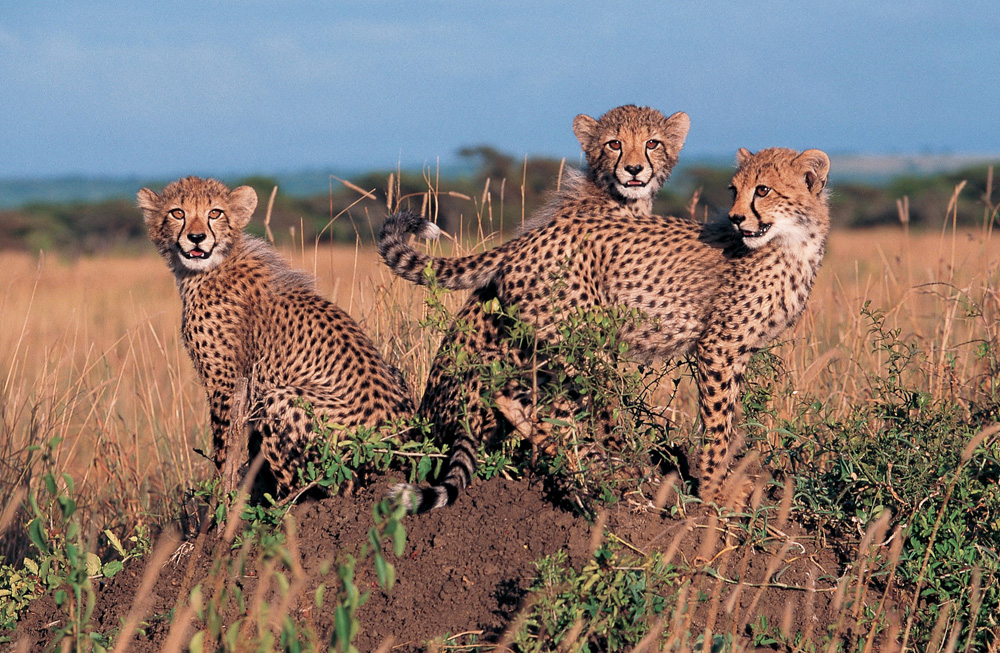
To these four-month old cubs, termite mounds make irresistible foci for play rather than for vigilance. Young cubs have excellent eyesight but they are poor at spotting danger and also make many mistakes in identification, responding fearfully to harmless species such as korhaans and cranes. By about the age of five to six months, cubs are better able to distinguish genuine danger and respond appropriately.
Despite a reputation of being somehow reproductively impoverished, wild cheetahs can be unexpectedly successful at meeting these challenges. Throughout the majority of its range, the cheetah is not threatened by an inability to perpetuate the species, and indeed, given the right conditions, is prolific. Yet although science has recently revealed a great deal about cheetah reproduction, it remains one of the least known and most contradictory facets of the species’ biology. As this chapter will reveal, cheetahs rarely mate yet have lots of cubs; female cheetahs make excellent mothers but lose most litters; and, least understood of all, cheetahs consistently fail to breed in captivity yet are prodigious reproducers in the wild.
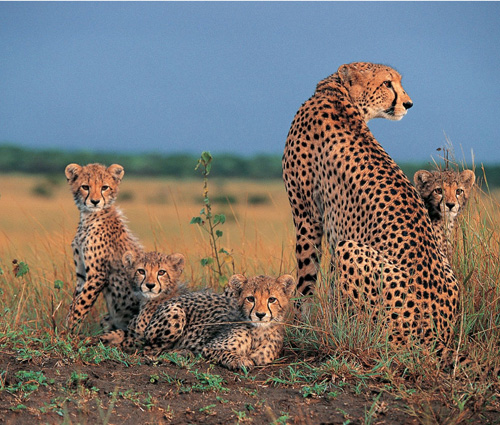
REPRODUCTION IN CAPTIVITY
In contrast to their wild counterparts, cheetahs in captivity suffer from a baffling combination of obstacles when it comes to reproduction. Captive cheetahs are reluctant to mate, females often fail to conceive when they do, and despite the best of care, cubs often die – around 35 per cent of captive cubs do not reach six months of age.
Initially, physiology was blamed. Male cheetahs have poor-quality sperm but this is true for both captive and wild individuals, and the latter certainly have no problem siring cubs. Attention then turned to the females, but over 80 per cent of captive females are fertile and, physiologically, should have no difficulty conceiving.
Husbandry is increasingly considered the standout issue, but even here there are no clear trends. For example, the centuries-old tradition of exhibiting cheetahs in male-female pairs is now obsolete and many zoos mimic the cheetah’s social system in the wild, keeping groups of males separate from solitary females until they come on heat. The method has yielded great success with some facilities, notably South Africa’s De Wildt Cheetah Centre, which has bred over 600 cubs, yet precisely the same approach – and every possible variation on it – repeatedly fails in many other institutions. The research and experimentation is ongoing.
THE MATING SYSTEM
With their dichotomous social system of wide-ranging, solitary females and resident, sociable males, cheetahs have a problem when it comes to breeding – they have to find one another. Most species of large cats have a sophisticated repertoire of long-range calls that serve to advertise their presence. Both males and females use these vocalisations to warn off potential intruders of the same sex, but they also use calls to find mates. Indeed, to most human ears, the calls proclaiming territoriality and announcing sexual readiness are indistinguishable, but they clearly convey different messages to the intended audience. Lions, tigers, leopards, jaguars and pumas have come-hither calls that carry for kilometres – but cheetahs do not.
Female cheetahs in oestrus are essentially silent. Indeed, the overt signs that a female is in heat are extremely subtle. She typically loses interest in food for a day or two at the onset of oestrus and spends much of her resting time rolling pleasurably on the ground, but neither activity serves to attract distant males. Instead, cheetahs rely largely on scent marking. As a female approaches oestrus, elevated levels of reproductive hormones in her urine and faeces signify her condition, which males can doubtless detect. To enhance the likelihood of detec-tion, she defecates on prominent sites like termite mounds, large trees and koppies – the only time a female makes such an obvious show of her presence to other cheetahs.
On finding such a signpost, males spend as long as 45 minutes assessing it, inhaling the telltale signals over a sensory depression in the palate called the Jacobson’s or vomeronasal organ. Cats grimace dramatically as they evaluate a scent mark, in a characteristic expression called flehmen. In cheetahs, flehmen is very subtle but like all cats, it serves to waft the hormone-laden smells over the Jacobson’s organ, allowing them to judge the age of scent marks. Although no one has tested the cheetah’s ability to discriminate smells of different ages, it is known that domestic cats can differentiate between old and fresh scent marks at the very least. Cheetahs almost certainly use the information to decide whether or not it is worth searching for the owner.
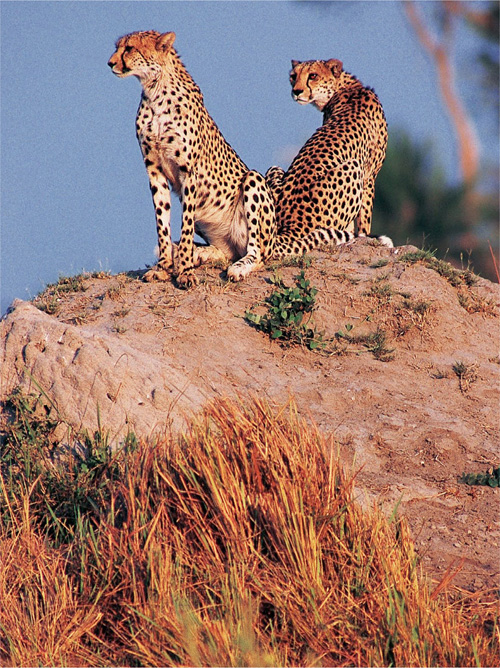
This adolescent female is too young to be interested in finding a mate but like all cheetahs, she gravitates to high places to observe her surroundings. Like the female, the two males are searching for predators or prey but unlike her, they also use high points to look for possible reproductive partners.
When a deposit is fresh, the males’ excitement is unmistakable. They tirelessly search the area, trotting hurriedly between prominent features of the landscape and checking them assiduously for an olfactory update. Their urgency is driven by the high possibility that the female will elude them. The female habit of wandering may see her pass through a male home range in a day or two, and females display little evidence of actively searching for males. They may even avoid them; on seeing other cheetahs in the distance, females – even those in oestrus – typically lie low and show no inclination to investigate. So it falls largely to the males to find mates and they invest considerable haste in doing so. Even if they are not following the trail of a female broadcasting her readiness to mate, males will opportunistically dash over to any distant cheetah they encounter, hoping – presumably – that it is a female on their patch.
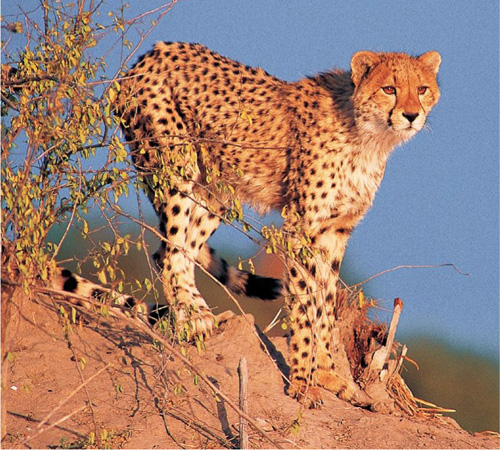
When the males succeed, the resulting encounter can be a surprisingly aggressive one, in which the female appears anything but enthusiastic.
FIELD NOTES: JULY 21
06:25: The female Mahamba is resting on a large termite mound when I see two males approaching from about 250 metres away. They have seen her and begin trotting in to explore, their postures low and aggressive. Mahamba is snoozing and fails to see them until they are about 30 metres away. She spots them and immediately takes flight, slinking down off the termite mound and rushing away, but they catch up with her in 50 metres. The lead male knocks her to the ground and she rolls frantically on her back with a shrill squeal. The second male rushes in and there is a cacophony of calls from all three animals. Mahamba remains lying on the ground, growling, yelping and stuttering at the males, who return the calls and repeatedly ‘attack’ her. They smack at her with their front paws and seem to bite her flanks, though none of the assaults appears serious; she is not injured. Time and again, the males attempt to sniff her hindquarters, stuttering constantly, but she protests violently each time and turns on them, provoking another spectacular round of ‘fighting’. This carries on for the entire day with no indication that Mahamba is anywhere near ready to mate or that the males are losing interest.
Harassment like this from the males is customary though the reasons for it are far from clear. One theory suggests that it enhances the female’s receptivity by encouraging competition between the males but, in fact, virtually all the ‘hostility’ is directed towards the female and aggression between coalition members is very rare. When competition does occur, it is very mild and more likely to happen once mating has begun: two males were observed competing to mount a female by using their heads to push each other off her. Equally, the possibility that the process stimulates her to ovulate is doubtful; females are induced into ovulating but, in common with a number of cat species, it is the mating itself which brings about the release of eggs. The obvious conclusion is that the exchange occurs because the female is not interested – indeed, it is more severe when females are not in oestrus – but even successful matings are usually presaged by apparent reluctance from the female and bullying behaviour by the males.
When a female is ready to mate, chances are no one will see it. In stark contrast to other cat species (when habituated to tourists or researchers), cheetahs are astonishingly covert about mating. Mating is thought to happen largely under cover of night, and if there is dense vegetation nearby, the female will seek it out, drawing the males with her. Furthermore, it is all over very quickly. Typically feline, each mating lasts for less than a minute; distinct in cheetahs, however, it takes place very rarely. Mating bouts in captivity are usually separated by protracted periods of inactivity lasting many hours and, in fact, the few observations that exist of cheetahs mating in the wild report a single copulation. Perhaps this is all it takes for a female to conceive; oestrus in cheetahs lasts for a maximum of three days (compared to around five for lionesses) but it can be truncated to less than a day when mating occurs. Other than insemination, male cheetahs play no direct role in reproduction. Like most cats, the female cheetah does the rest on her own.
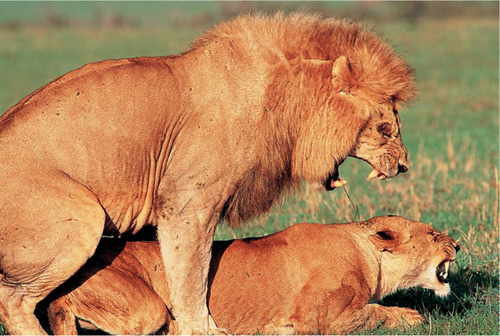
WHY DO CATS HAVE SO MUCH SEX?
With the possible exception of the cheetah, cats have prodigious sex lives. As many an awestruck safari-goer can testify, lions mate hundreds of times over the female’s three to five day oestrus, a pattern displayed by most cat species even if few are as conspicuous about it as lions. But exactly why do cats have so much sex?
The reason probably lies in females’ maximising their reproductive success. Frequent copulations increase the likelihood that females mate with numerous males – which can hold several advantages. First, it may test each male’s genetic quality through ‘sperm competition’ in which only the most active, healthy sperm succeeds in fertilising the eggs. Moreover, if different males contribute sperm to a female, the resulting litter will have enhanced genetic diversity, perhaps increasing its prospects of survival in unpredictable conditions (see Chapter 6, pages 118–120). Finally, female promiscuity may also inhibit potential cub-killers by deceiving every male who mated a female into believing that he sired her cubs – whether he did or not. In cheetahs, the obscurity of the entire reproductive process means the theories remain wholly untested and, indeed, the question may not even apply.
MATERNAL INSTINCTS
Why cheetahs mate so infrequently or so secretly is a mystery, but it is certainly no indication of their reproductive capacity. Females can conceive for the first time before they are two years of age and most will be serially pregnant or raising cubs for all their adult lives. One old captive female was fertile until age 15 (though most wild cheetahs do not survive that long). Whereas only about 16 per cent of females in captivity ever succeed in conceiving, at least 95 per cent of wild females will have at least one litter, and most will have many.
Close to the end of pregnancy, females devote time to finding a suitable place to give birth. Lairs are typically hidden in patches of thick vegetation, in koppies and in tall grass or reeds. In open areas, females seek out drainage lines to give birth, being particularly careful about finding a suitable site high on the bank and never on the bottom where flooding is a danger. In the Sahara Desert, where sites are at a premium, females hide their cubs in caves among scattered rocky massifs or, more commonly, in the appropriated burrows of striped hyaenas or jackals and even inside the large excavations of the spurred tortoise.
On a larger scale, females need to be sure the lair is well situated to provide for the demands of raising cubs. As with most mammals, the period a female is suckling is the most energetically costly stage of reproduction, so the best-located lairs are those reasonably close to prey. The female also needs access to water to replenish the fluids lost through lactation. In the Serengeti, around 68 per cent of lair sites are found within 500 metres of water and in all, an estimated 90 per cent of lairs have daily access to water. Females in marginal habitats, such as the Sahara, almost never have easy access to water or high densities of prey. Not enough is known of the desert cheetah’s biology to predict how this affects reproduction, but it is probable that mothers in the Sahara are often unable to meet their energetic demands and are forced to abandon many of their litters.
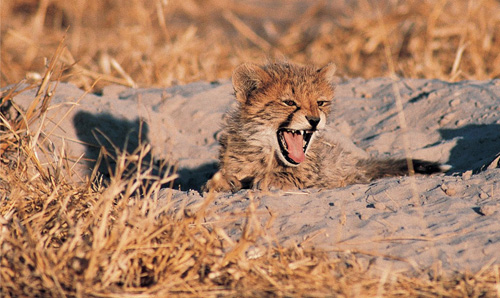
A young cheetah at the front of a burrow being occupied as the den in Botswana. In predator-rich savannah habitats, using burrows such as this is very rare, mainly because they are readily occupied by spotted hyaenas and other dangerous competitors. In contrast, burrows are often used as dens in arid north Africa where hyaenas are rare.
After a gestation of 90 to 98 days, the female gives birth. Litters average three to four cubs but are often substantially larger; litters of five and six are quite common, and there are numerous observations documenting as many as eight. The record for a wild female falls to a mother in Kenya who was photographed with nine young cubs (though the possibility exists that some were adopted – see Chapter 3, page 48). Compared to other large cats, newborn cheetah cubs are very small, weighing around 250 to 300 grams – less than a can of cat-food. Small cubs are possibly a trade-off for having so many of them. Given the energetic costs of pregnancy, female cats can be viewed as making a reproductive ‘choice’ between producing large litters of small cubs or small litters of large ones. Opting for large litters may boost the chances that some cubs will survive. It may also be a way a pregnant cheetah maintains her ability to hunt – females still need to run down prey up until a couple of days before giving birth, a gruelling task that would be dangerously hampered by heavy litters.
The period in the lair is one of the most dangerous times for cubs, and mothers move them often. Presumably, the lair accumulates the smell of the cubs and increases the danger of attracting predators; mothers who give birth where large predators – especially lions – are uncommon or extinct may never move their cubs. Typically, though, females relocate their litters about every five to six days, with the longest period spent at the birth site. Very young cubs have little odour and some females use the first lair for up to three weeks before the first shift. In typical feline fashion, mothers carry young cubs by the scruff of the neck, or sometimes more haphazardly.
FIELD NOTES: JULY 12
12:55: I am waiting near the den-site of the Umziki Marsh female when she suddenly emerges with a cub in her mouth; it is about two weeks old. She is holding the cub by the tail but after walking about 20 metres, she puts it down gently and picks it up again, this time holding it by the body in the way dogs often carry their pups. I remain at the lair and follow her progress with binoculars. She moves only about 150 metres into a date-palm thicket, where she evidently deposits the cub and emerges empty-mouthed. She repeats the process with the rest of her litter (six cubs in all), carrying all of them by the body except one, which she transports by the neck. When there are no more cubs to shift, she returns a final time and sniffs the old lair for about three minutes; cheetahs must not be able to count – or perhaps she is just being thorough!
Whether cheetahs can count has never been put to the test, but mothers never leave a cub behind. They are equally careful about not attracting attention to the lair, most often leaving to hunt a couple of hours after sunrise, when lions and hyaenas have usually sought out a daytime rest-site. Similarly, mothers return to the lair during the heat of mid-afternoon or shortly after dusk, when their chances of being observed are minimised. While the mother is hunting, young cubs may be left for periods ranging from a few hours to as long as 28 hours, but stretches of more than a full day are the exception. Mothers only stay away from their litters overnight during periods of prey shortages, which force them to hunt far from the lair.
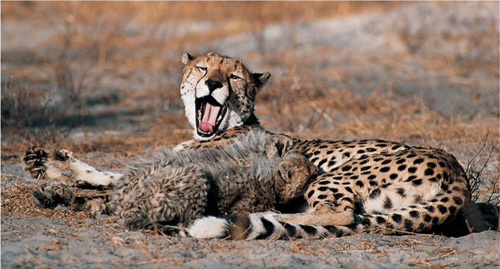
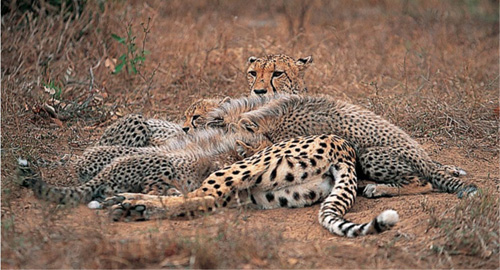
At about three months of age, the cubs in the top picture have about another month before they will be weaned. Where foraging is particularly productive, females sometimes suckle their cubs for longer; the litter in the lower picture is five-and-a-half months old.
Despite the female’s diligence, many young cubs die. On the short-grass plains of the Serengeti, less than 30 per cent of cubs survive to emerge from the lair. By far the greatest culprit is the lion, which accounts for almost nine out of ten losses from Serengeti lairs. Spotted hyaenas and leopards also kill litters, and black-backed jackals are quite capable of taking young cubs, although there are no eye-witness accounts. There is even a record of a secretary bird killing a very young cheetah cub dropped by its mother in the open when she was harassed by tourists; it is unlikely to have been discovered otherwise. Aside from predation, females are occasionally forced to abandon young litters if they have to cover prohibitively large distances when hunting – which is why productive home ranges are so important. Heavy downpours (which may lead to hypothermia and pneumonia) and grass fires also claim a small percentage of young litters.
Fortunately, in the event that a female loses a litter, her oestrus cycle resumes almost immediately. On average, cheetahs will be pregnant again within 19 days of losing a litter. One Serengeti female conceived only two days after her cubs were killed. Such rapid resumption of reproduction is thought to be yet another adaptation to high cub losses. Whatever the evolutionary impetus, the cheetah’s fecundity in the wild is beyond doubt; its reproductive performance in captivity, however, is far less clear-cut (see box ‘Reproduction in captivity’ on page 65).
DO MALE CHEETAHS COMMIT INFANTICIDE?
Infanticide – in which males kill unrelated offspring sired by a rival – is one tactic by which a male can increase his reproductive output. The fierce competition for territory among male felids means that most will only ever enjoy a brief breeding stint and simply do not have the luxury of waiting for females to raise unrelated offspring before resuming oestrus. Killing cubs accelerates the process and is typically observed when a new male takes over a territory and inherits the females that go with it. The process is best known from lions but tigers, leopards, pumas, lynxes, ocelots and even feral domestic cats are known to do it.
Cheetahs, however, are not. Despite decades of observation, including many encounters between males and mothers with young cubs, infanticide has never been observed. Doubtless, males are the sires in many such cases, but often they are not. Given that females who lose litters resume oestrus rapidly, male cheetahs should profit from killing unrelated cubs. So why do they not? Most likely, the migratory movements of females preclude the potential benefits. Unlike cats in which the females are territorial (which includes all those listed above), there is no guarantee a female cheetah will remain in the area after the loss of a litter; she is just as likely to mate with the owner of a neighbouring territory or, indeed, any male. In small reserves where the movements of females are more predictable, it is theoretically more likely, and perhaps scientists will yet observe it. But for now, infanticide seems to be outside the cheetah’s behavioural repertoire.
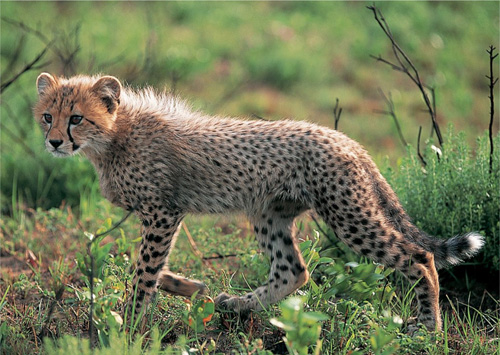

The cheetah’s distinctive coinlike spots begin as indistinct smudges in the cubs and gradually resolve as they age. The pattern of spots is unique to the individual and, as the owner of one tame cheetah once determined by counting every one, each cheetah has about 2 000 of them.
CUB COLORATION
Cheetah cubs are born with a very distinctive mantle of smoky-grey hair that covers their neck, shoulders and back, and lasts until they are about three months old. Theories abound as to its function. An enduring one suggests that the mantle mimics the two-toned ‘warning’ coloration of the honey badger, a powerful, pugnacious little carnivore generally left alone by much larger predators. Perhaps it fools aerial hunters like large eagles, but the honey-badger theory seems unlikely, given the cubs’ extreme vulnerability to ground-based predators. More believably, the mantle probably serves to camouflage young cubs in grassy habitats and may also help keep them warm while their ability to regulate their body temperature is still develop-ing. Even so, none of the explanations is entirely satisfactory and all await proper scientific testing.
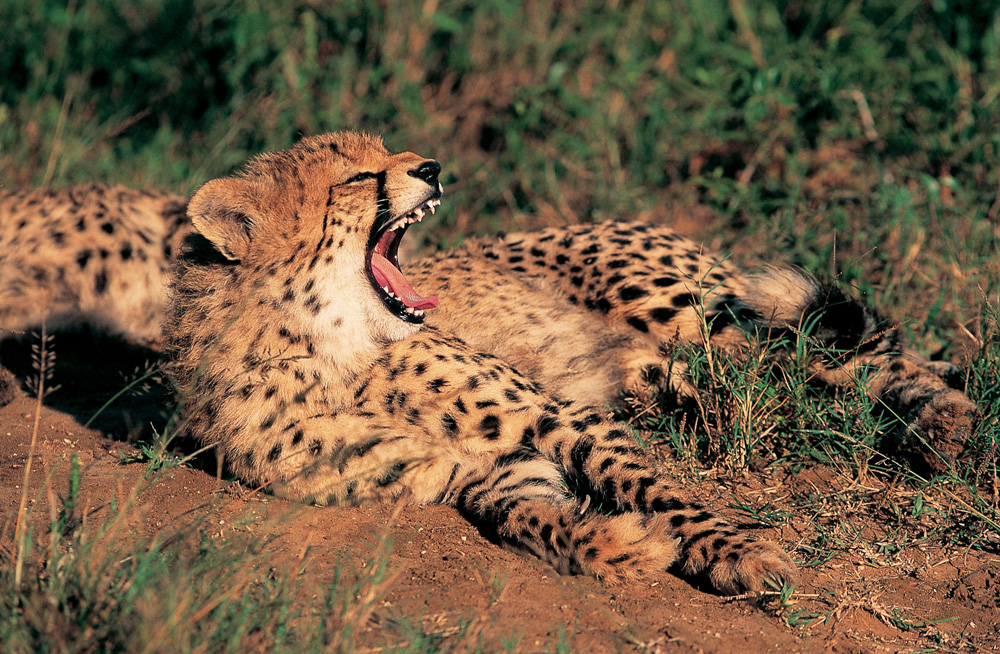
A four-month-old cub yawning, showing juvenile dentition or ‘milk teeth’. Adult dentition first appears around eight months of age and is fully erupted by about a year.
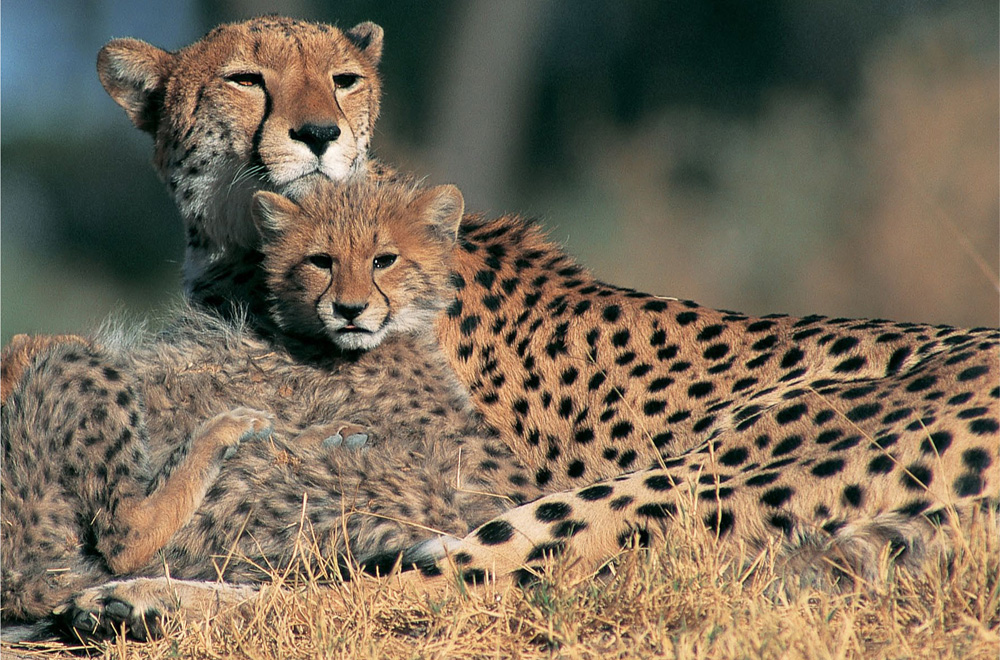
Mother cheetahs are tolerant and affectionate parents. When resting, the mother remains in close contact with her cubs, a pattern that often persists until the day she abruptly leaves her young adult offspring.

The chasing games of young cheetahs are extremely physical and are often joined by the cubs’ mother. Even the members of male coalitions will play-chase one another, though the percentage of their day spent in play is far less than that displayed by cubs.
RAISING THE CUBS
By the time the cubs are about eight weeks old, the mother will have quit the lair for the last time and the family will travel together. Cubs of this age are highly mobile, though they will remain vulnerable to predators for some months. Once they are 16 to 18 weeks old, cheetah cubs can outrun most potential predators, but until then their survival is dependent primarily on their mother’s vigilance. Compared with lone females, mothers spend a greater proportion of their day alert, improving the chances of seeing a predator far in the distance so that she can usher young cubs to safety before they can be detected. Occasionally, though, the early warning system fails.
FIELD NOTES: JUNE 6
18:30: Mahamba and her four cubs are resting on a shallow rise just after last light when a single lioness suddenly appears. She is upon them without warning and the cheetahs scatter into the darkness. I am sure the cubs have enough of a head start to escape but when I catch up with the lioness after about 200 metres, I am shocked to see she has caught one of the cubs. The cub is still alive and screaming as the lioness mauls its hindquarters. Mahamba is very distressed, circling about 15 metres away and moaning as though to distract the lion. The lioness drops the cub, which is still alive, and briefly chases Mahamba, then rushes back. Again she attacks the cub which, in a moment of desperation, twists in the lioness’ paws and bites her on the chest. The lioness immediately bites the cub through the head and thankfully, it is killed instantly.
Attacks like this will claim many more cubs in the weeks immediately after they leave the lair. Counting losses in the lair and after emergence, a staggering 19 out of 20 cheetah cubs born on Tanzania’s short-grass plains do not survive to independence. Importantly, though, the Serengeti figures probably represent the most extreme losses experienced by a cheetah population. The density of predators – especially lions – is very high and the plains offer few refuges against them: cubs are visible to predators from as far away as two kilometres. However, in denser woodland habitat where vegetation is very varied, lairs are less likely to be discovered and cubs are less likely to be seen. If they are spotted, they are often able to hide until the danger has passed.
FIELD NOTES: MARCH 9
17:25: Ilanga and her five cubs have just left the remains of a nyala kill (female, adult) when they bump into a pride of 11 lions. The cheetahs bombshell into the surrounding woodlands with lions chasing them. There is absolute chaos. I cannot see where any of the cubs are, but at one stage I see Ilanga chasing a two-year old male lion. She pursues him for about 100 metres, slapping him at least three times on the backside while I have them in sight. He suddenly seems to wake up to the fact that he is three times her size and turns on her. She disappears into a drainage line with the lion in pursuit. The rest of the pride are scattered about, apparently searching for the cheetah cubs. They persist for 20 minutes and then move off; I cannot see if they have caught any of the cubs. Ilanga reappears looking extremely stressed. She spends about 10 minutes calling quietly and listening, but there is no response. She pauses a while, perhaps to reassure herself the lions are definitely gone, and begins to yelp more loudly. I see one cub appear from a croton patch about 90 metres away and then another from further off. She continues calling until, by 19:20, all the cubs have returned. Judging by the time it took for the last cub to return, some of them had probably hidden hundreds of metres away.
The advantage of cover for woodland mothers translates into a far higher success rate than for females on the plains; as many as 70 per cent of cubs born in the closed woodlands of South Africa’s Phinda Game Reserve in KwaZulu-Natal survive to independence. It has long been assumed that dense vegetation makes poor habitat for cheetahs but, in fact, it is probably crucial for their reproduction. If the 95 per cent mortality rate experienced by plains cubs applied consistently to all cheetah populations, the species would die out. With this in mind, zoologists are now scrutinising the less conspicuous cheetahs that inhabit the woodland areas surrounding the Serengeti plains. If they are anything like South African females, they are the key to the cheetah’s persistence in the Serengeti. In zoological jargon, the woodland population probably acts as a source, enjoying high cub survival to the point that it exports individuals to the plains sink – a population in reproductive decline, which could not possibly endure on its own.
Life as a cub is fraught with threats, but dangerous encounters are quite rare and, if they are not resting or feeding, cheetah cubs are usually playing. Games are a furiously vigorous combination of wrestling, chasing and grappling with one another over such desirable objects as sticks, grass clumps or inedible body parts of prey like skin and tails. Play mirrors many of the behaviours that in later life are crucial for hunting and avoiding predators – for example, cubs instinctively swat at the legs of fleeing siblings in the same style that adults use to trip prey. However, the extent to which their games are a rehearsal for the serious business of being an adult cheetah is still unclear. Preliminary research suggests some advantages: cubs that often play-stalk their siblings are more likely to stalk prey species, and litters that often engage in social play are better able to seize prey released by the mother. However, whether this translates into their being more efficient hunters when it really matters has not yet been determined.
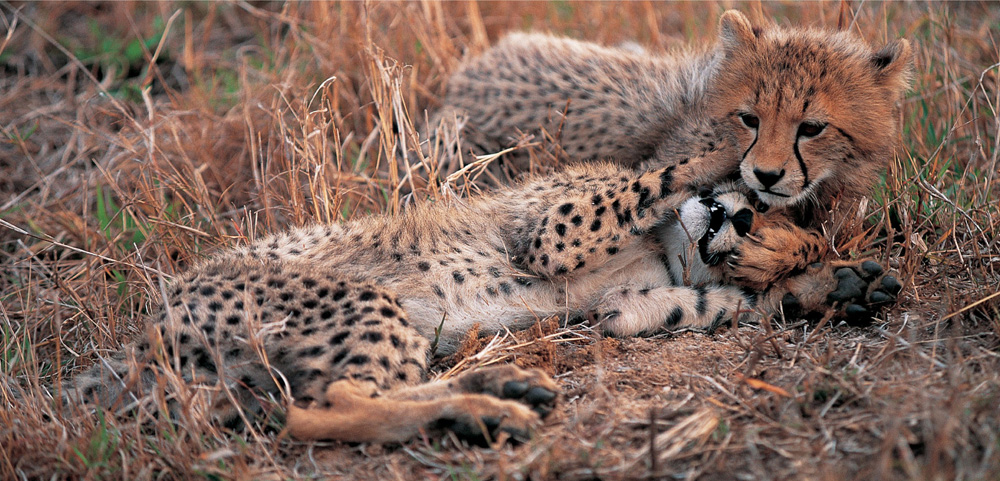
Cheetah cubs play extremely energetically with one another but aggression and injury in their games is very rare. Despite the showing of claws below, the grip would be gentle and there is little chance of injury to siblings.
Similarly, and more surprisingly, the role of predatory training by the female in producing efficient hunters is controversial. Mothers begin releasing live prey in front of their cubs when they are as young as three months (but more commonly from about five months), providing chances for the cubs to practise their skills. However, young cheetahs can be quite inept at dealing with prey.
FIELD NOTES: NOVEMBER 3
14:25: Mahamba has just caught a young impala. As her six-month-old cubs race to join her, she releases it alive (though with a large gash in its flank from her dewclaw). The lamb stumbles towards the nearest cub, which suddenly halts its approach and hisses nervously. The lamb is clearly dazed and stands immobile, with the cubs milling around, evidently uncertain of the next move. Two cubs take turns to tap it gently on a hind leg but it does not move. The cubs lose interest and sit or lie around. At one point, the impala nudges a cub in the ribs as though trying to suckle. After 10 minutes, Mahamba walks to the impala and quickly suffocates it. As though on cue, the cubs rush to the carcass and begin feeding.
It is hard to believe that the female’s maternal encouragement holds no advantages, and although no one has ever tested the idea, cubs probably do become better hunters than if training were to be withheld. They certainly assume an increased role in suffocating the prey as they mature and possibly learn other refinements along the way, which ensures just enough competency to survive. Starvation is rare among newly independent cheetahs so, despite being poor hunters when they separate from their mother and the fact that they remain entirely reliant on her until then, young cheetahs seldom die because they cannot feed themselves.

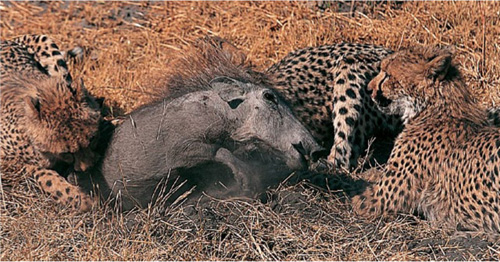

A female cheetah (sitting upright in lower picture) assists her two cubs in tackling a young warthog. Holding back by the female as shown in the upper right photograph is typical of the ‘training’ process, presumably to allow the cubs to accumulate valuable experience in handling prey.
The greatest period of improvement takes place when their mother leaves the cubs, usually when they are about 18 months old, though it can occur as young as 13 months, while some litters stay with their mothers until they are two. Mothers generally initiate the parting, typically because the reproductive imperative has come full circle and they are pregnant again. Females often conceive while they are still accompanied by large cubs but always leave them to give birth, a rapid turnaround that means females have a litter every 15 to 19 months. Compared with the similarly sized leopard (which takes around two years), it is a statistic that makes cheetahs one of the fastest reproducers among large cats.
Once their mother disappears to have her next litter, newly independent adolescents routinely stay together in a unit known as a sib-group, which remains in the mother’s range. Grouping in young cheetahs increases their chances of making a kill while still developing their hunting abilities though, intriguingly, it does not mean they eat more – they make larger kills more often, but have to share the spoils with their siblings. There are, however, further advantages to staying together. The individuals in a sib-group can each afford to devote less time to watching for danger, and groups are less likely than individuals to be harassed by other predators, particularly hyaenas. For females in a sib-group, the advantages of sociality begin to wane as they approach sexual maturity, and they leave after about six months. They will almost certainly inherit some of their mother’s range while, as described in the previous chapter (see page 44), the males usually move away, ensuring – though not consciously – that they avoid breeding with their female relatives.
Wherever young cheetahs go on to settle, by the time they are three years old, both females and males will have reached some important benchmarks in their lives as adults. Most of the females will have just had their first litter, while the males will be on the road to territorial acquisition, and all of them will have developed into expert hunters.

A female cheetah with near-grown cubs, Botswana. The chances are high that these cubs will now survive to independence; but once on their own, the young adults – especially the males – face many challenges to their survival. Among cheetahs on the Serengeti plains, females reaching independence have a high probability of reaching old age, but most males will not survive beyond six years of age.